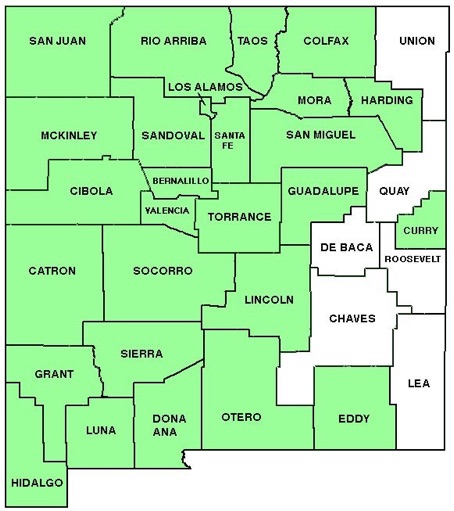WILDFLOWERS OF NEW MEXICO
Like tiny scarlet goblets, waxy-looking flowers cover clumps of bristly, cylindrical stems that often squeeze between boulders and along cracks in rocks, or form rounded mounds of 5–20+ stems. The stems reach 8–inches tall, 4-inches wide, with 6–14 ribs lined with straight spines. Note the short, white felt on the areoles at the base of the spines, and the flowers grow from the upper stem, not the apex. This species has separate male and female plants.
FLOWER: March–June. The 1–2 1/2-inch wide (3–7 cm) flowers develop on the sides of the stem and have stiff, round-tipped, red petals (tepals), often with greenish-white or yellowish bases, and a green stigma that stands above the cluster of filaments with pinkish-purple anthers. Male plants produce grayish-purplish pollen and females produce fruit. Fruit is egg-shaped, 3/4–1 1/2-inches long (20–38 mm), fleshy, green maturing red with white pulp, and with clusters of tiny spines until ripe.
SPINES: Rounded (not narrow, elongated) areoles have short, white felt and 1–4 central spines and 7–12+ radial spines; centrals are 1–3-inches (25–75 mm) long and project outward; radials are 3/16–1 1/2-inches long (5–40 mm) and spread over the rib. The large central spines taper and are usually round, not angled, in cross-section.
HABITAT: Gravelly, sandy soils, rocky foothills, canyons, slopes; desert grasslands and scrub to mountain ridges in spruce-fir forests.
ELEVATION: 4,200–10,000 feet.
RANGE: AZ, CA, CO, NM, NV, TX, UT.
SIMILAR SPECIES: This species forms hybrids with the yellow-flowering Texas Rainbow Cactus, E. dasyacantuus, widespread in NM. The crosses, E. x roetteri, occur in Otero Co. and adjacent Texas, and bloom with a rainbow pallet of flower colors. Kingcup, E. triglochidiatus, in much of the state, has 5–8 ribs, areoles also with short, white felt, 1–10 radial spines, and 0–1 central spine angular in cross-section. The E. triglochidiatus complex originally included E. coccineus. Arizona Claret Cup, E. arizonicus, in sw NM, has stems that reach 4–6-inches wide with 9–10 ribs.
NM COUNTIES: Statewide in mid- to high-elevation habitats except Chaves, De Baca, Lea, Quay, Roosevelt, Union counties.
NOTES: Unlike most cacti with yellow to purple flowers with weak, pointed petals adapted for insect pollination, claret cups and kingcups have bright red flowers to attract hummingbirds, rounded petals rigid enough for a perch, and remain open 2–3 days. The flowers are sized to fit hummingbirds heads, while plants with red, tubular flowers are sized to fit hummingbird bills.

CLARET CUP CACTUS
ECHINOCEREUS COCCINEUS
Cactus Family, Cactaceae
Perennial cactus


THE CONTENTS OF THIS WEBSITE ARE COPYRIGHTED AND CANNOT BE USED
WITHOUT PERMISSION OF GEORGE OXFORD MILLER



Short, white, woolly felt at the base of the mature areoles, and round spines (arrow).



Fruit grows from sides of stem and has tiny spines until ripe.
Clumps of Claret Cup cacti at 10,000 feet in the Magdalena Mts., Socorro county.

Range Map for
Echinocereus coccineus
EMAIL ME
Specialized pollination: The rigid, red tepals of kingcup and claret cacti make perfect landing pads for hummingbirds, and the cacti flowers are sized to fit hummingbird heads. Bees also pollinate the nectar-rich flowers.